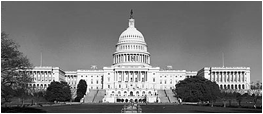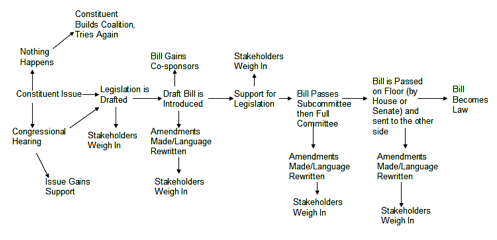Learning to Do Historical Research: Sources
How Laws Get Created
Liese Dart
Emma Schroeder
A basic overview of the branches of government and how these processes work can help you find government documents. If you understand how government works, you can track an issue from inception to law. Tracking the documents produced along the way can help environmental historians paint a much clearer picture of social movements in space and time, and it ensures that a story’s dissenting opinions are recognized. In order to discover what federal government documents are available, you have to think your way through government structure and what documents are produced at each step.
The Structure of Federal Government
There are three branches of government.
- Legislative
- Executive
- Judicial

Image: The United States Capitol Building
The Legislative Branch is the lawmaking body of government. This branch is comprised of the Congress which is broken into two houses: the House and Senate. There are 435 members of the House of Representatives and 100 members of the Senate. Members of Congress are responsible for introducing legislation on behalf of their constituents.
The Executive Branch is comprised of the President and his Cabinet (Secretaries). Secretaries serve as the heads of government departments. Departments, commissions, and agencies are responsible for interpreting the laws passed by Congress and administering government programs created by those laws.
The Judicial Branch is comprised of the four federal courts: the Supreme Court, the District Courts, the Court of Appeals (Circuit Court), and the Court of Bankruptcy.
Return to Top of Page
The Legislative Branch: Making Laws
It is the responsibility of the Congress to make new laws and amend existing ones. Oftentimes legislative action begins with a representative’s constituents. Citizens, trade organization or industries, private companies, advocacy groups, and other institutions meet with Congressional staff to begin talks on an issue. This practice of lobbying begins to shape the components of a bill.
Documents are produced all along the legislative process and can be a gold mine of information on how environmental conflicts arise, where laws originated, who they are intended to benefit, the political strength of a movement, and the timeline of an issue. They can even help clarify partnerships between seemingly disparate groups. Much information can be attained about the political and cultural atmosphere of an issue by the way an issue moves through Congress.
The Ideal Steps to Making a Law
1. First, a constituent raises an issue. A Member agrees to sponsor a bill and begins to look for co-sponsors. Letters are sent between offices to ask for support for the legislation.
a. Constituents build partnerships with other groups to support the bill.
2. If the bill has momentum it will be read before the Congressional Committee with jurisdiction over the relevant part of the United States code. Some bills will move towards a committee vote.
a. Amendments are made to the bill.
b. If the bill passes out of the committee with jurisdiction, it is sent to the House or Senate floor.
3. Once the bill passes on the floor, it is sent to the opposite side (the House or the Senate) for further modification and for a vote.
a. Almost always, further modifications are made to the original language. These compromises can win or lose votes.
4. If an agreement is reached between the House and the Senate, the bill is passed and presented to the President for his signature. If no compromise is reached, the bill will be rejected and both sides are sent back the drawing board.

Key Legislative Documents
Although documents are created all along the legislative journey, some are more accessible than others. When researching the legislative history of an issue, look for these three types of documents:
- Letters and Statements of Support for Legislation
- Committee Hearing Reports
- Voting Records
Hearing Reports from Congressional Committees
Congressional committees act as the research centers for Congress. All members of Congress serve on one or more committees. Committee reports serve as evidence to set the framework for creating a new law.
“Congressional hearings” are scheduled events, usually open to the public, at which an issue of relative importance is addressed. Similar to a trial, expert witnesses are called to testify before committee members on the issue.
The documents produced from a fair and balanced hearing will lead you towards the breadth of public opinions on an issue. Most Congressional testimony is available to the public. You can glean a lot of important information on an issue by looking at the hearing report and reading the opening statements from members of the Committee and testimony from the stakeholders invited to participate in the hearing.
Visit http://thomas.loc.gov/home/schedules.html to see a schedule of today’s hearings on Capitol Hill.
Voting Records
Committee and floor votes force Members of Congress to take a stand on legislation, whether they are ready or not. Voting records can be used to help determine who supported legislation and what the issues are that made the language of the bill contentious. Voting records can indicate a party line split, regional or demographic boundaries around an issue, or rural verses urban biases.
What types of committees can affect the environmental regulations?
Although most any Congressional committee can pass a bill which affects the environment, here are a few committees that are highly relevant to environmental laws:
- Senate Agriculture, Nutrition and Forestry
- Senate Energy and Natural Resources
- Senate Environmental and Public Works
- House Agriculture
- House Energy and Commerce
- House Natural Resources
Return to Top of Page
What Happens After a Bill Becomes a Law?
Federal agencies, commissions and departments within the Executive Branch of government carry out the tasks set forth in law by Congress. Laws can alter regulations, jumpstart programs, and establish entirely new government agencies. Legislators must appropriate funds within the federal budget to carry out the tasks set forth in the new law.
Numerous documents are produced by a federal agency during the implementation and lifetime of any program. There are four types of governmental bodies within the Executive Branch that are tasked with implementing new laws:
- Executive Departments are led by an appointed member of the President's Cabinet, for example the Department of the Interior (www.doi.org). Within the departments there are agencies such as the Fish and Wildlife Service (www.fws.gov/)
- Independent Agencies and Government Corporations like the Environmental Protection Agency (/www.epa.gov/)
- Boards, Commissions and Committees, for example the Marine Mammals Commission (www.mmc.gov/)
- Quasi Governmental Agencies like the Smithsonian Institution (www.si.edu/) in Washington D.C.
These types of government agencies are good places to look for documents about your topic of interest.
Return to Top of Page
| 
